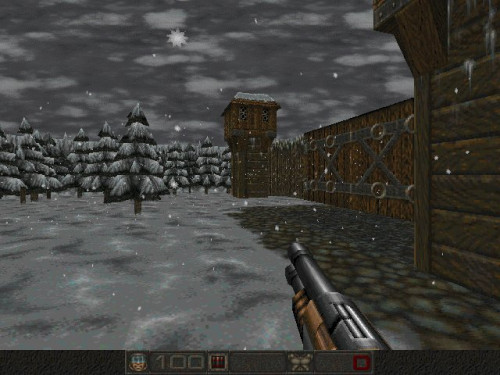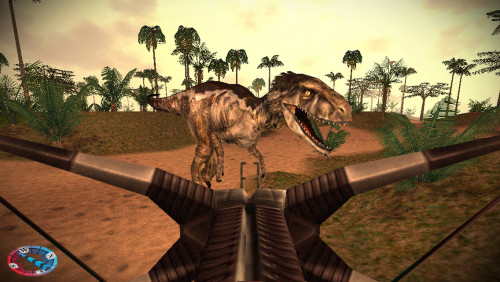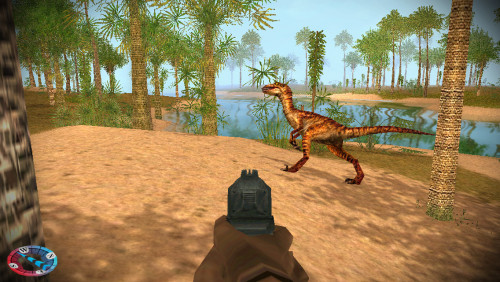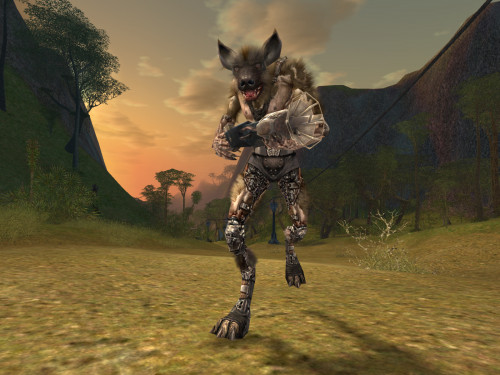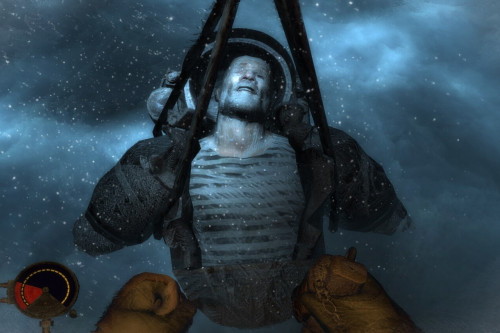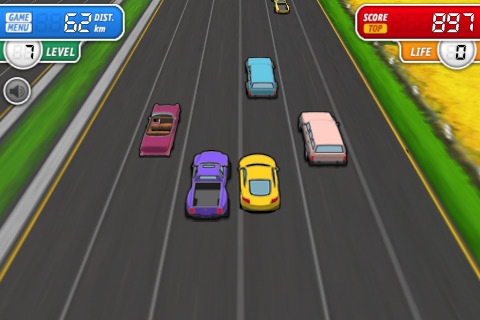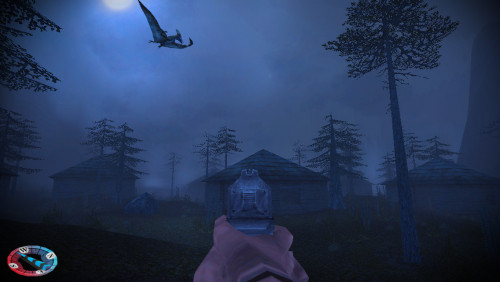On January 23, an HD edition of the classic Carnivores: Dinosaur Hunter was released on Steam on Greenlight. On this occasion, we talked about the history of the game with Igor Karev, responsible for its creation and reissue.

Alexander Semenov (Editor-in-chief of App2Top): How did the Carnivores series come about? The hunting simulator genre (especially the dinosaur hunting simulator) is a narrow niche, why did they take it up?
Igor Karev (founder of Action Forms and Tatem games): It’s an interesting story. Back in ’95, when we were developing Chasm: The Rift, it was quite difficult to sign a publishing contract with an unknown studio from Ukraine. But we found a small publisher who believed us and took up the project.

Igor Karev
In 1997, when we finished and released the game Chasm, this small publisher re-signed our contract with GT Interactive, a large American company that at one time released such famous games as Doom, Blood, Unreal. We didn’t see any royalties from the sales of Chasm, since the small publisher went bankrupt.
Chasm: The Rift
GT Interactive was preparing to release Deer Hunter at that time. This is a series about deer hunting.
After the release of Deer Hunter GT Interactive told us that the sales of the project are cosmic. Then her representative hinted that it would be nice for us to move in this direction too. They say, “what do you do after Chasm, don’t you want to do some action about hunting?”
We were just developing our engine, one of the features of which was the support of large open spaces. We sat, thought about it and decided that it was a good idea. So they took up the development of a dinosaur hunting simulator.
Why did you decide to hunt them, and not, for example, the same deer?
We didn’t want to hunt deer or any wild animals, it seemed somehow boring. Then there were still fresh memories of the acclaimed film “Jurassic Park”, which was released in 1993. So we decided to take the dinosaur theme.
After talking to the publisher, we made a demo version, showed GT Interactive, they got interested, and then disappeared (no contracts, advances, etc.).
When we ourselves released an announcement about the development, posted this demo version for people to download, GT Interactive abruptly appeared and said that they were now ready to sign a contract.
We signed up and promptly released the first part. In the wake of the success of the first Deer Hunter, sales of the first Carnivores also went well.
Carnivores: Dinosaur Hunter
What were the sales like?
In total, the entire line of Carnivores games has sold about a million copies.
How difficult was it to develop the game?
It was difficult to develop Chasm, our first project. That’s when there were no people, no experience. Everything was very difficult.
At the time of the release of Chasm, we already had a team, and we were young – no obstacles.
But there were difficulties, of course, when creating Carnivores. For example, we could not afford to increase the team: then there were not enough people on the market and we had a small budget for the development of the first part.
However, we had enough of what we have to implement the project and, if I’m not mistaken, we did it in a year. As far as I remember, it took us even less for the second part and Ice Age: less than a year for each project.
How many people were in the team?
Maybe fifteen people. Maybe even less.
After the release of the first Carnivores, in the wake of its success, we increased the team to 20 employees.
We have always worked with a compact team. Our people were multifunctional. We did not hire specialists of a narrow profile, this would lead to an increase in the budget. We had people doing both 3D modeling and concept art.
Why, after the success of the first part, did they not “inflate” the team more significantly?
Our basic principle was and remains now, there should be enough people to cope well with development tasks. That composition was quite enough for us.
But in parallel with the development of the second part of Carnivores, we began to try new genres. For example, it was interesting for us to try to create a strategy. Then we increased the team solely for the sake of several people doing prototyping.
At that time, this was not called prototyping, but creating a demo version.
Another reason why we did not undertake to increase the number of employees was our ideology. We wanted the company to remain a family, a “business for fun” that earns money and brings pleasure. We were more focused on this, and not on becoming a giant “pc software house” or “game development house”.
Carnivores: Dinosaur Hunter
If we talk about such a family type of development, what are its pros and cons?
The main advantage is the motivation of the team. There is no need to force anyone and demand anything, communication in the team is well established. Everyone has one single goal: to release a good game so that it would be interesting to play by themselves. That was our main motivation back then.
For all the people who came to us, it was a mandatory criterion that they should play what we do. The game was supposed to be interesting for every employee. A dream game.
This then became a minus for us.
After the release of Carnivores Ice Age (the third game in the series), we signed a contract with 3D Realms to develop Duke Nukem: Endangered Species. They also decided that now hunting games are selling cool and “let’s put Duke Newkema in some kind of hunt.”
We did everything quickly enough. Based on our engine, the game was assembled in less than a year. But 3D Realms closed the project, leaving us with all the content, in fact the whole game, only without their main character. After that, we decided that we had already released 4 games, spent a year on development, learned something – we are doing a big project. And instead of releasing the game we made for 3D Realms, we decided to start a completely new project.
So we started creating a “Vivisector”. It was 2002.
It was during its development that our “making a dream game” approach went sideways. If I’m not mistaken, we have been developing the project for about three and a half years. We had a lot of concept changes, a lot of management mistakes that, due to the nepotism of the business, did not allow us to fully scale it, scale the team, arrange full-fledged processes with project management, milestones that need to be sustained, development became unpredictable… We were all still making the dream game.
As I remember, the project was expected. You were one of the first teams to introduce the mech simulation. Plus, your monsters were flying apart, and it was clear that these were separate parts – you were also one of the first to do this. And there were many such revolutionary features.
Vivisector was technologically a powerful game at that time. Visually, of course, after three years of development, the game suffered and compared to competitors, it did not look so modern, but technological things were cool.
When we made a skeleton for animals, we “built up” body weight on top of the skeleton. And we had spot hits. Accordingly, if you hit some part of the arm, then not the whole arm flew off, as we had in Chasm, namely a piece of meat. It was really cool, it looked very cool. Then one of my partners, Yaroslav Kravchenko, who at that time was the main game designer and art director, said: “These are animals, we need to convey all the charm of the animal in the form of beautiful fur.” The idea was great and we also started doing it.
And all these features, of course, were not laid down when planning the project, but appeared along the way, which, of course, negatively affected the release date.
“Vivisector”
I was surprised when you just said that there were managerial mistakes. I look at the Carnivores release schedule, and everything is strict there. The first part – 1998, the second – 1999, then Ice Age – 2001. A very strict schedule. And it is surprising that the processes were debugged in this way, but a larger project could not be debugged. Why is that?
A small team worked on Carnivores, which did not need to be “kicked”. Everyone clearly knew what needed to be done. And we had, basically, a fairly tight schedule for the start of the game. Publishers long before the release of the game agreed with distributors, with stores about placement on the shelf. To miss the moment was quite risky and problematic for the company.
At the time of the second Carnivores, we had a well-established communication with GT Interactive producers, we did not deviate from the project deadlines. When we started working with 3D Realms after Carnivores, it greatly affected our development processes. Because the “scope”, the scope of work, changed periodically: new features were constantly added, the approval process took quite a long time, although we, for our part, constantly tried to keep everything in the “scope” that we agreed on. And it, in principle, would be enough.
How was the work on Carnivores usually built? What were the stages at that time, how was the production line built?
In the beginning, there was an approximate vision of what kind of game we want to make. We are writing a fairly short concept document describing the most important and necessary features and capabilities of the game. While working on the first version, there was more documentation due to the novelty of the project, even then we drew the level design on paper and talked through all the details in advance, but for the second part and Ice Age, we compiled a very short list of new features and their functional description, which the whole team focused on in the future.
After that, each of the team takes the piece that is ready to do. And begins to do. In our team, as I have already told you, people were multifunctional and did everything very, very quickly. And if we saw that there was some kind of delay, we quickly cut off the moment that was slowing us down.
Another of the big advantages is that our lead programmer, also my partner in Action Forms, Oleg Slyusar, is a system guy who said that if we didn’t provide something technically, then we won’t include it, we don’t waste time. He technically limited game designers in solving certain tasks. And this had a positive effect on the development time. We could do what we had in mind without “inflating” some things. Sometimes, of course, there were moments when he said that it was unrealistic to do what Yaroslav had come up with, but in the morning this feature was already made in our engine and the game only got better from this.
You just said that everyone took on a piece of tasks and did it. Do I understand correctly that there was, relatively speaking, democracy in the team? Wasn’t there a team leader who distributed tasks and then tightly controlled them?
There was democracy, but we had one person, Yaroslav, who was responsible for the integrity of the project. In fact, he was a “Project Owner”. He played nonstop in the working versions and determined what was missing in the game, what to fix or remove altogether. It seems to me that this is an important moment when there is a person who represents the game in detail, how it begins and how it ends, what connecting elements there are in the game. In a word, Yaroslav followed the integrity of the game.
Many things still went through the stages of internal discussion. It was quite democratic. We all lived by this project. We lived each of these projects, constantly discussing how to do something better in this game, staying within the time limit that we had set for development. We could have delayed the internal milestones, but we were still going to launch the game on time.
After Carnivores Cityscape, we stopped hearing about the series. What happened? Are you tired, sales have gone down, or something else?
The team is tired of making the same type of games
After the release of Ice Age, the publisher said: “Let’s make another big game – Cityscape, where we will add a city.” We didn’t agree on the development with them, and they gave it to Sunstorm Interactive.
Accordingly, Carnivores Cityscape was not made by us. For that studio, it was a “work for hire” project, the team did it completely callously, which greatly affected the quality of the game and sales, respectively. Cityscape was the last game in the Carnivores lineup.
The sales of Cityscape showed that either the time of hunting has passed, or the series simply could not be developed further.
Carnivores Cityscape
As far as I understand, you returned to the series only when you released it on mobile?
Here I can tell you about Tatem Games itself, which is currently releasing Carnivores on Steam.
In 2002, as part of Action Forms, I decided to try to take some first steps in “self-publishing”. At that time, I wanted to try to do something quickly, and most importantly publish games myself. PC game development takes months, if not years. Then the idea arose to make a mobile direction. With the help of Oleg Slyusar and several other guys who worked in Action Forms – one programmer and one artist – we made a couple of games for Palm OS devices. Fast enough: in a month and a half the games were ready. They were mostly puzzles. The choice of a development platform was also interesting. Then on mobile devices it was possible to do for J2ME, Windows CE and Palm OS. There were no specialists in our studio with knowledge of J2ME, users of Windows handhelds did not seem to me to be the target audience, but Palm developed cool devices and it was possible to program for it in C++. We had enough of such specialists, so we decided to focus on them.
One of our released games was called Pocket Aquarium: there is an aquarium with fish, you need to take care of them periodically, feed the fish and clean the aquarium. The game was successfully published and sold, which showed that the mobile market is interesting. But we continued to develop the “Vivisector”, so we put the work at Tatem Games on pause, although after seeing the presentation of the first iPhone, I was sure that it would be a great device that would change the mobile market thanks to the large screen and touch at that time. Periodically I thought that as soon as they open access for developers, something must be done.
After passing the “Suspended Animation” in early 2009, it became clear that we would not continue the PC development of large projects because of the crisis that had begun, then I resumed the work of Tatem Games.
“Suspended animation”
Two questions at once. The first is about Palm OS. It’s 2002, there’s no iPhone, nothing. How successful were the sales? Was the development just paying off, or was it possible to earn decent money on communicators?
At that time, everything was sold as a premium game: paid and installed. Our distribution channels at that time were mainly sites where you could quickly place the game. The competition was quite weak. Pocket Aquarium has sold 20-30 thousand copies. Then it was cool. Money was collected from all sites, despite the fact that the initial investment in the project amounted to several thousand dollars. It turned out well. But I made a mistake and did not continue this direction. I came back and focused again on PC projects.
The second question is about “Suspended animation”. As far as I remember, it was a major project. It was of a high level for the CIS market. And it is not focused on him. So why didn’t Action Forms survive the 2008-2009 crisis after all?
We have always planned and focused our projects on the global market. Then sales of boxed versions began to fall, while global digital distribution had not yet begun, it was quite difficult to launch a new project on a PC and sign a publisher ready to get involved in a long and expensive development. Another decisive factor was the delay in the release of the game caused by the protracted development. We had attempts to enter the market of browser games, casual projects, but nothing happened.
It turns out that this is a turning point. You said you went back to Tatem Games. How closely were they related to Action Forms?
These are different legal entities. I unite them as a co-founder of Action Forms and Tatem Games.
When it became clear that we were no longer engaged in PC games, but were concentrating exclusively on mobile – in fact, we were becoming a startup and entering a market unfamiliar to us – most of the team considered this a risky idea and decided to leave. We had a big shift in the structure. Action Forms went into suspended animation, and several people moved to Tatem Games and we started everything from scratch. And I am very grateful to the people who stayed with me for believing me and working hard to release our first game on iOS.
Is Carnivores your first mobile project?
The first game we made was Racer. It was an experiment for us. It was unclear to us how this market works, how iOS works. I wanted to do something quickly, start up, “feel”, so to speak. Racer we made a team of three people. The development took 3-4 months.
When Racer was released as a premium game (there were no other models), and I saw the first sales, I was taken aback. I even thought that we should go back to PC development.
Racer
In the first week, Racer sales were very low, although after the release it was written about in the press. The editor-in-chief of TouchArcade even wrote how he loves Racer, how he plays it, hung screenshots and his glasses there, asked if readers could interrupt them.
Then I wrote a letter to Apple and asked them to take a close look at our game. They replied that they themselves choose whose games to consider.
But a couple of days later we receive–I’ll never forget–an email from Apple. They wrote: “Here at Apple we love your Racer game” (We at Apple love your Racer game, – approx. editors) and added that they plan to place the game on the main page. Then the main sales began.
We got into the Top 30 in the American App Store, after that we released a “free” version with the transition to a paid one, it also received a feature. In total, the game has been downloaded by more than three million people.
An interesting story turned out with Carnivores on mobile. We already sort of understood what the iOS market is, how it works: we had to do something further. And then one day in the office, we were discussing different concepts and thought… why not Carnivores? The rights have already been returned to us, we can do it. They were a little skeptical about the idea: an old game that hardly anyone remembers, hunting, and even with difficult controls on the smartphone screen. But after the first tests, we saw that it would be cool.
How successful has the port become?
This is our most successful project on the mobile platform. To date, more than 32 million people have played it on iOS and Android devices. Got into the Top 10 paid apps in America. Apple has also helped with the promotion here.
Why didn’t they release a sequel on mobile platforms?
We periodically started developing a new game, but the lack of ready-made technologies at that time that would cope with the open spaces necessary for the world of Carnivores affected. Unlike Deer Hunter, which is more like a shooting gallery, we give players the opportunity to wander through huge levels in search of their dinosaur, and this requires technology that can quickly display these locations on mobile devices. Today we have the concept of the new Carnivores game ready, we have made technical measurements of the engines, so we will start development soon.
But, probably, it’s more that we wanted to try something different, some new genres. Unfortunately, many prototypes did not go into development, but one direction appeared, casual SIM managers, which we are actively developing now.
Then the series was restarted on PlayStation 3. How well did the project go on the console?
It turned out that we remained within the framework of our expertise on mobile and wanted to continue to increase expertise on this platform. We periodically read in the comments in mobile stores that users would like to play Carnivores on consoles, so we decided it was a good idea. First ported to Sony PSP. The game sold well there, and later I turned to my friends from Vogster. I have known Max Novikov for more than 20 years, he helped us in the development of Chasm. Max supported this idea, especially since they had a lot of experience on consoles and PC.
Carnivores: Dinosaur Hunter Reborn
They financed this development, developed the console version themselves, and later Max took up the PC version. In fact, we gave them a license to use our IP, on the basis of which they made a completely new product.
How successful was the launch?
To be honest, we expected more. At that time, more than 20 million people had already played the mobile version, and the PSP version also performed well. In general, we were sure that the game should give good results on consoles, but we were wrong. Apparently, some of the miscalculations were directly in the evaluation of the audience.
This is probably due to the dynamics of the game. We read reviews of the game on the console. Many still expected that it would be more action than a slow and unhurried dinosaur hunt. We were waiting for such a full-fledged shooter in which you can chase dinosaurs. I think this is one of the reasons.
And now you are coming out on Steam, and you are not coming out with a new version, but with a remaster. Why? Are you trying to find the ground, to understand how relevant the genre is? Or some other task?
I see that old PC games are actively returning to the market now. And the audience is actively playing them.
One of the main ideas is to give users the opportunity to play that old game, only with improved graphics and new features (for example, fast relocation on the map, a new Survive game mode has been added for fans of active shooting, we plan to support the Steam controller). In fact, Carnivores: Dinosaur Hunter is a combination of two PC versions of the original Carnivores, where locations, dinosaurs and weapons from the two games are mixed, but the whole gameplay is the same.
So the main reason for the appearance of the remaster: the desire to return the game to the PC. The second reason is that I want to see how this market is being operated now, how it is possible to work on it. At Tatem Games, we want to expand our horizons, work not only on mobile platforms.
Carnivores: Dinosaur Hunter
Last question: when to wait?
Now the game is on Greenlight. We still need to collect a certain number of votes so that the Steam audience gives the green light. But the game itself is in active development. In March, we plan to release it on Steam.

